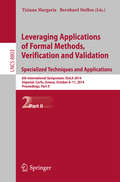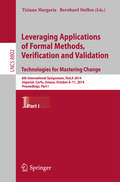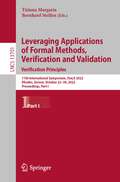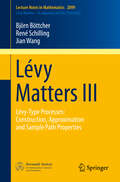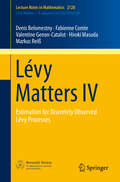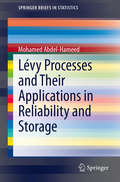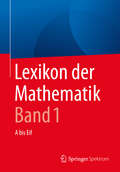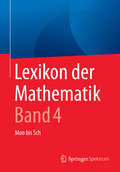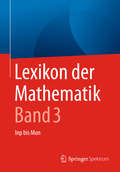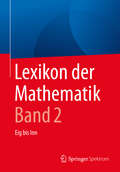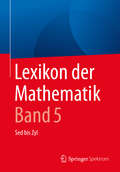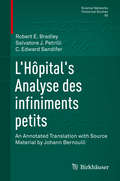- Table View
- List View
Leveraging Applications of Formal Methods, Verification and Validation. Specialized Techniques and Applications: 6th International Symposium, ISoLA 2014, Imperial, Corfu, Greece, October 8-11, 2014, Proceedings, Part II (Lecture Notes in Computer Science #8803)
by Tiziana Margaria Bernhard SteffenThe two-volume set LNCS 8802 and LNCS 8803 constitutes the refereed proceedings of the 6th International Symposium on Leveraging Applications of Formal Methods, Verification and Validation, ISoLA 2014, held in Imperial, Corfu, Greece, in October 2014. The total of 67 full papers was carefully reviewed and selected for inclusion in the proceedings. Featuring a track introduction to each section, the papers are organized in topical sections named: evolving critical systems; rigorous engineering of autonomic ensembles; automata learning; formal methods and analysis in software product line engineering; model-based code generators and compilers; engineering virtualized systems; statistical model checking; risk-based testing; medical cyber-physical systems; scientific workflows; evaluation and reproducibility of program analysis; processes and data integration in the networked healthcare; semantic heterogeneity in the formal development of complex systems. In addition, part I contains a tutorial on automata learning in practice; as well as the preliminary manifesto to the LNCS Transactions on the Foundations for Mastering Change with several position papers. Part II contains information on the industrial track and the doctoral symposium and poster session.
Leveraging Applications of Formal Methods, Verification and Validation. Technologies for Mastering Change: 6th International Symposium, ISoLA 2014, Imperial, Corfu, Greece, October 8-11, 2014, Proceedings, Part I (Lecture Notes in Computer Science #8802)
by Tiziana Margaria Bernhard SteffenThe two-volume set LNCS 8802 and LNCS 8803 constitutes the refereed proceedings of the 6th International Symposium on Leveraging Applications of Formal Methods, Verification and Validation, ISoLA 2014, held in Imperial, Corfu, Greece, in October 2014. The total of 67 full papers was carefully reviewed and selected for inclusion in the proceedings. Featuring a track introduction to each section, the papers are organized in topical sections named: evolving critical systems; rigorous engineering of autonomic ensembles; automata learning; formal methods and analysis in software product line engineering; model-based code generators and compilers; engineering virtualized systems; statistical model checking; risk-based testing; medical cyber-physical systems; scientific workflows; evaluation and reproducibility of program analysis; processes and data integration in the networked healthcare; semantic heterogeneity in the formal development of complex systems. In addition, part I contains a tutorial on automata learning in practice; as well as the preliminary manifesto to the LNCS Transactions on the Foundations for Mastering Change with several position papers. Part II contains information on the industrial track and the doctoral symposium and poster session.
Leveraging Applications of Formal Methods, Verification and Validation. Verification Principles: 11th International Symposium, ISoLA 2022, Rhodes, Greece, October 22–30, 2022, Proceedings, Part I (Lecture Notes in Computer Science #13701)
by Tiziana Margaria Bernhard SteffenThis four-volume set LNCS 13701-13704 constitutes contributions of the associated events held at the 11th International Symposium on Leveraging Applications of Formal Methods, ISoLA 2022, which took place in Rhodes, Greece, in October/November 2022. The contributions in the four-volume set are organized according to the following topical sections: specify this - bridging gaps between program specification paradigms; x-by-construction meets runtime verification; verification and validation of concurrent and distributed heterogeneous systems; programming - what is next: the role of documentation; automated software re-engineering; DIME day; rigorous engineering of collective adaptive systems; formal methods meet machine learning; digital twin engineering; digital thread in smart manufacturing; formal methods for distributed computing in future railway systems; industrial day.
Lévy Matters I: Recent Progress in Theory and Applications: Foundations, Trees and Numerical Issues in Finance (Lecture Notes in Mathematics #2001)
by Thomas Duquesne Oleg Reichmann Ken-iti Sato Christoph SchwabLévy Matters II: Recent Progress in Theory and Applications: Fractional Lévy Fields, and Scale Functions (Lecture Notes in Mathematics #2061)
by Serge Cohen Alexey Kuznetsov Andreas E. Kyprianou Victor RiveroThis is the second volume in a subseries of the Lecture Notes in Mathematics called Lévy Matters, which is published at irregular intervals over the years. Each volume examines a number of key topics in the theory or applications of Lévy processes and pays tribute to the state of the art of this rapidly evolving subject with special emphasis on the non-Brownian world. The expository articles in this second volume cover two important topics in the area of Lévy processes. The first article by Serge Cohen reviews the most important findings on fractional Lévy fields to date in a self-contained piece, offering a theoretical introduction as well as possible applications and simulation techniques. The second article, by Alexey Kuznetsov, Andreas E. Kyprianou, and Victor Rivero, presents an up to date account of the theory and application of scale functions for spectrally negative Lévy processes, including an extensive numerical overview.
Lévy Matters III: Lévy-Type Processes: Construction, Approximation and Sample Path Properties (Lecture Notes in Mathematics #2099)
by Björn Böttcher René Schilling Jian WangThis volume presents recent developments in the area of Lévy-type processes and more general stochastic processes that behave locally like a Lévy process. Although written in a survey style, quite a few results are extensions of known theorems, and others are completely new. The focus is on the symbol of a Lévy-type process: a non-random function which is a counterpart of the characteristic exponent of a Lévy process. The class of stochastic processes which can be associated with a symbol is characterized, various schemes constructing a stochastic process from a given symbol are discussed, and it is shown how one can use the symbol in order to describe the sample path properties of the underlying process. Lastly, the symbol is used to approximate and simulate Levy-type processes.This is the third volume in a subseries of the Lecture Notes in Mathematics called Lévy Matters. Each volume describes a number of important topics in the theory or applications of Lévy processes and pays tribute to the state of the art of this rapidly evolving subject with special emphasis on the non-Brownian world.
Lévy Matters IV: Estimation for Discretely Observed Lévy Processes (Lecture Notes in Mathematics #2128)
by Denis Belomestny Fabienne Comte Valentine Genon-Catalot Hiroki Masuda Markus ReißThe aim of this volume is to provide an extensive account of the most recent advances in statistics for discretely observed Lévy processes. These days, statistics for stochastic processes is a lively topic, driven by the needs of various fields of application, such as finance, the biosciences, and telecommunication. The three chapters of this volume are completely dedicated to the estimation of Lévy processes, and are written by experts in the field. The first chapter by Denis Belomestny and Markus Reiß treats the low frequency situation, and estimation methods are based on the empirical characteristic function. The second chapter by Fabienne Comte and Valery Genon-Catalon is dedicated to non-parametric estimation mainly covering the high-frequency data case. A distinctive feature of this part is the construction of adaptive estimators, based on deconvolution or projection or kernel methods. The last chapter by Hiroki Masuda considers the parametric situation. The chapters cover the main aspects of the estimation of discretely observed Lévy processes, when the observation scheme is regular, from an up-to-date viewpoint.
Lévy Matters V: Functionals of Lévy Processes (Lecture Notes in Mathematics #2149)
by Lars Nørvang Andersen Søren Asmussen Frank Aurzada Peter W. Glynn Makoto Maejima Mats Pihlsgård Thomas SimonThis three-chapter volume concerns the distributions of certain functionals of Lévy processes. The first chapter, by Makoto Maejima, surveys representations of the main sub-classes of infinitesimal distributions in terms of mappings of certain Lévy processes via stochastic integration. The second chapter, by Lars Nørvang Andersen, Søren Asmussen, Peter W. Glynn and Mats Pihlsgård, concerns Lévy processes reflected at two barriers, where reflection is formulated à la Skorokhod. These processes can be used to model systems with a finite capacity, which is crucial in many real life situations, a most important quantity being the overflow or the loss occurring at the upper barrier. If a process is killed when crossing the boundary, a natural question concerns its lifetime. Deep formulas from fluctuation theory are the key to many classical results, which are reviewed in the third chapter by Frank Aurzada and Thomas Simon. The main part, however, discusses recent advances and developments in the setting where the process is given either by the partial sum of a random walk or the integral of a Lévy process.
Lévy Matters VI: Lévy-Type Processes: Moments, Construction and Heat Kernel Estimates (Lecture Notes in Mathematics #2187)
by Franziska KühnPresenting some recent results on the construction and the moments of Lévy-type processes, the focus of this volume is on a new existence theorem, which is proved using a parametrix construction. Applications range from heat kernel estimates for a class of Lévy-type processes to existence and uniqueness theorems for Lévy-driven stochastic differential equations with Hölder continuous coefficients. Moreover, necessary and sufficient conditions for the existence of moments of Lévy-type processes are studied and some estimates on moments are derived. Lévy-type processes behave locally like Lévy processes but, in contrast to Lévy processes, they are not homogeneous in space. Typical examples are processes with varying index of stability and solutions of Lévy-driven stochastic differential equations.This is the sixth volume in a subseries of the Lecture Notes in Mathematics called Lévy Matters. Each volume describes a number of important topics in the theory or applications of Lévy processes and pays tribute to the state of the art of this rapidly evolving subject, with special emphasis on the non-Brownian world.
Lévy Processes: Theory and Applications
by Ole E. Barndorff-Nielsen Thomas Mikosch Sidney I. ResnickA Lévy process is a continuous-time analogue of a random walk, and as such, is at the cradle of modern theories of stochastic processes. Martingales, Markov processes, and diffusions are extensions and generalizations of these processes. In the past, representatives of the Lévy class were considered most useful for applications to either Brownian motion or the Poisson process. Nowadays the need for modeling jumps, bursts, extremes and other irregular behavior of phenomena in nature and society has led to a renaissance of the theory of general Lévy processes. Researchers and practitioners in fields as diverse as physics, meteorology, statistics, insurance, and finance have rediscovered the simplicity of Lévy processes and their enormous flexibility in modeling tails, dependence and path behavior. This volume, with an excellent introductory preface, describes the state-of-the-art of this rapidly evolving subject with special emphasis on the non-Brownian world. Leading experts present surveys of recent developments, or focus on some most promising applications. Despite its special character, every topic is aimed at the non- specialist, keen on learning about the new exciting face of a rather aged class of processes. An extensive bibliography at the end of each article makes this an invaluable comprehensive reference text. For the researcher and graduate student, every article contains open problems and points out directions for futurearch. The accessible nature of the work makes this an ideal introductory text for graduate seminars in applied probability, stochastic processes, physics, finance, and telecommunications, and a unique guide to the world of Lévy processes.
Lévy Processes and Their Applications in Reliability and Storage (SpringerBriefs in Statistics)
by Mohamed Abdel-HameedThis book covers Lévy processes and their applications in the contexts of reliability and storage. Special attention is paid to life distributions and the maintenance of devices subject to degradation; estimating the parameters of the degradation process is also discussed, as is the maintenance of dams subject to Lévy input.
Levy Processes, Integral Equations, Statistical Physics: Connections and Interactions (Operator Theory: Advances and Applications #225)
by Lev A. SakhnovichIn a number of famous works, M. Kac showed that various methods of probability theory can be fruitfully applied to important problems of analysis. The interconnection between probability and analysis also plays a central role in the present book. However, our approach is mainly based on the application of analysis methods (the method of operator identities, integral equations theory, dual systems, integrable equations) to probability theory (Levy processes, M. Kac's problems, the principle of imperceptibility of the boundary, signal theory). The essential part of the book is dedicated to problems of statistical physics (classical and quantum cases). We consider the corresponding statistical problems (Gibbs-type formulas, non-extensive statistical mechanics, Boltzmann equation) from the game point of view (the game between energy and entropy). One chapter is dedicated to the construction of special examples instead of existence theorems (D. Larson's theorem, Ringrose's hypothesis, the Kadison-Singer and Gohberg-Krein questions). We also investigate the Bezoutiant operator. In this context, we do not make the assumption that the Bezoutiant operator is normally solvable, allowing us to investigate the special classes of the entire functions.
Lewis Carroll in Numberland: His Fantastical Mathematical Logical Life
by Robin WilsonLewis Carroll's books have delighted children and adults for generations, but behind their exuberant fantasy and delightful nonsense was the mind of a brilliant mathematician. Now his forgotten achievements in the world of numbers are brought to light by acclaimed author and mathematician Robin Wilson. Here he explores the curious imagination of a man whose pioneering work at Oxford University included investigations into voting patterns and tennis seeding, who dreamt up numerical conundrums in bed at night and who filled his writings with problems, paradoxes, puzzles and teasing games of logic. Taking us into a world of mock turtles and maps, gryphons and gravity, Lewis Carroll in Numberland reveals the singular mind of a genius.
Lexi Magill and the Teleportation Tournament
by Kim LongFor fans of The Amazing Race, Lexi Magill and the Teleportation Tournament is the perfect adventure for middle grade readers who like scavenger hunts and puzzle-solving.Twelve-year-old physics whiz Lexi Magill won't let anything stop her from winning Wisconsin's Teleportation Tournament--the annual competition where teams teleport around the world to solve science-based puzzles. She needs the prize money if she wants to re-enroll in the science academy her parents can no longer afford. Added bonus: she'll be able to reconnect with her best friend Haley.But Lexi's two teammates put a wrench in her plans. When one misreads a clue that lands the team in a castle in Germany, and the other loses her teleportation medallion in Poland, Lexi wonders what she's gotten herself into. Struggling to keep her team under control as the race rages on, Lexi not only has to figure out how to get back on course (literally), but she must decide how far she's willing to go to win, and who her real friends are. With riddles to solve and messages to decode, this interactive read won't disappoint!
Lexi Magill and the Teleportation Tournament
by Kim LongFor fans of The Amazing Race, Lexi Magill and the Teleportation Tournament is the perfect adventure for middle grade readers who like scavenger hunts and puzzle-solving.Twelve-year-old physics whiz Lexi Magill won't let anything stop her from winning Wisconsin's Teleportation Tournament--the annual competition where teams teleport around the world to solve science-based puzzles. She needs the prize money if she wants to re-enroll in the science academy her parents can no longer afford. Added bonus: she'll be able to reconnect with her best friend Haley.But Lexi's two teammates put a wrench in her plans. When one misreads a clue that lands the team in a castle in Germany, and the other loses her teleportation medallion in Poland, Lexi wonders what she's gotten herself into. Struggling to keep her team under control as the race rages on, Lexi not only has to figure out how to get back on course (literally), but she must decide how far she's willing to go to win, and who her real friends are. With riddles to solve and messages to decode, this interactive read won't disappoint!
Lexical Collocation Analysis: Advances and Applications (Quantitative Methods in the Humanities and Social Sciences)
by Pascual Cantos-Gómez Moisés Almela-SánchezThis book re-examines the notion of word associations, more precisely collocations. It attempts to come to a potentially more generally applicable definition of collocation and how to best extract, identify and measure collocations. The book highlights the role played by (i) automatic linguistic annotation (part-of-speech tagging, syntactic parsing, etc.), (ii) using semantic criteria to facilitate the identification of collocations, (iii) multi-word structured, instead of the widespread assumption of bipartite collocational structures, for capturing the intricacies of the phenomenon of syntagmatic attraction, (iv) considering collocation and valency as near neighbours in the lexis-grammar continuum and (v) the mathematical properties of statistical association measures in the automatic extraction of collocations from corpora. This book is an ideal guide to the use of statistics in collocation analysis and lexicography, as well as a practical text to the development of skills in the application of computational lexicography. Lexical Collocation Analysis: Advances and Applications begins with a proposal for integrating both collocational and valency phenomena within the overarching theoretical framework of construction grammar. Next the book makes the case for integrating advances in syntactic parsing and in collocational analysis. Chapter 3 offers an innovative look at complementing corpus data and dictionaries in the identification of specific types of collocations consisting of restricted predicate-argument combinations. This strategy complements corpus collocational data with network analysis techniques applied to dictionary entries. Chapter 4 explains the potential of collocational graphs and networks both as a visualization tool and as an analytical technique. Chapter 5 introduces MERGE (Multi-word Expressions from the Recursive Grouping of Elements), a data-driven approach to the identification and extraction of multi-word expressions from corpora. Finally the book concludes with an analysis and evaluation of factors influencing the performance of collocation extraction methods in parsed corpora.
Lexikon der Mathematik: A bis Eif
by Guido WalzDas fünfbändige "Lexikon der Mathematik" bietet in insgesamt ca.17.000 Stichworteinträgen einen umfassenden Überblick über die moderne Mathematik, ihre Fachterminologie und ihre Anwendungen. Die behandelten Fachgebiete reichen von klassischen Themengebieten wie Geometrie, Zahlentheorie und Geschichte der Mathematik – über Numerische Mathematik, Graphentheorie, Versicherungsmathematik und Optimierung – bis hin zu modernen Anwendungsbereichen wie etwa Wavelets, Codierungstheorie oder Neuronalen Netzen. Besondere Berücksichtigung finden die Biographien bedeutender Wissenschaftler von der Antike bis zur Gegenwart. Dadurch wird dem Umstand Rechnung getragen, dass gerade in der Mathematik eine Fülle von Verfahren, Methoden oder auch Lehrsätzen existieren, die nach berühmten Persönlichkeiten benannt sind – z.B. abelsche Gruppe, Satz des Pythagoras und euklidischer Algorithmus. Ein Charakteristikum des Werkes sind die zahlreichen Essays von international anerkannten Fachleuten, in denen entweder ein mathematisches Fachgebiet übersichtlich vorgestellt oder ein "Highlight" der Mathematik besonders gewürdigt wird. Im vorliegenden ersten Band finden Sie unter anderem Essays zu den Themen Arabische Mathematik und Codierungstheorie. Hauptzielgruppen des Lexikons sind neben Mathematikern in Schule, Hochschule und Wirtschaft vor allem Fachleute und Wissenschaftler benachbarter Disziplinen sowie mathematisch interessierte Laien.Mit der vorliegenden Neuauflage wird das in Umfang und Qualität auf dem deutschsprachigen Markt einzigartige Werk – 15 Jahre nach der Erstveröffentlichung – wieder lieferbar gemacht. Aus diesem Anlass wurden kleinere Ungenauigkeiten korrigiert sowie die Lebensdaten einiger inzwischen leider verstorbener Persönlichkeiten aktualisiert. Aufgrund rechtlicher Unklarheiten mussten die im Erstdruck enthaltenen Porträtabbildungen bekannter Mathematikerinnen und Mathematiker leider entfernt werden.
Lexikon der Mathematik: Moo bis Sch
by Guido WalzDas fünfbändige "Lexikon der Mathematik" bietet in insgesamt ca.17.000 Stichworteinträgen einen umfassenden Überblick über die moderne Mathematik, ihre Fachterminologie und ihre Anwendungen. Die behandelten Fachgebiete reichen von klassischen Themengebieten wie Geometrie, Zahlentheorie und Geschichte der Mathematik – über Numerische Mathematik, Graphentheorie, Versicherungsmathematik und Optimierung – bis hin zu modernen Anwendungsbereichen wie etwa Wavelets, Codierungstheorie oder Neuronalen Netzen. Besondere Berücksichtigung finden die Biographien bedeutender Wissenschaftler von der Antike bis zur Gegenwart. Dadurch wird dem Umstand Rechnung getragen, dass gerade in der Mathematik eine Fülle von Verfahren, Methoden oder auch Lehrsätzen existieren, die nach berühmten Persönlichkeiten benannt sind – z.B. abelsche Gruppe, Satz des Pythagoras und euklidischer Algorithmus. Ein Charakteristikum des Werkes sind die zahlreichen Essays von international anerkannten Fachleuten, in denen entweder ein mathematisches Fachgebiet übersichtlich vorgestellt oder ein "Highlight" der Mathematik besonders gewürdigt wird. Im vorliegenden vierten Band finden Sie unter anderem Essays über die Zahl und den Satz des Pythagoras. Hauptzielgruppen des Lexikons sind neben Mathematikern in Schule, Hochschule und Wirtschaft vor allem Fachleute und Wissenschaftler benachbarter Disziplinen sowie mathematisch interessierte Laien.Mit der vorliegenden Neuauflage wird das in Umfang und Qualität auf dem deutschsprachigen Markt einzigartige Werk – 15 Jahre nach der Erstveröffentlichung – wieder lieferbar gemacht. Aus diesem Anlass wurden kleinere Ungenauigkeiten korrigiert sowie die Lebensdaten einiger inzwischen leider verstorbener Persönlichkeiten aktualisiert. Aufgrund rechtlicher Unklarheiten mussten die im Erstdruck enthaltenen Porträtabbildungen bekannter Mathematikerinnen und Mathematiker leider entfernt werden.
Lexikon der Mathematik: Inp bis Mon
by Guido WalzDas fünfbändige "Lexikon der Mathematik" bietet in insgesamt ca.17.000 Stichworteinträgen einen umfassenden Überblick über die moderne Mathematik, ihre Fachterminologie und ihre Anwendungen. Die behandelten Fachgebiete reichen von klassischen Themengebieten wie Geometrie, Zahlentheorie und Geschichte der Mathematik – über Numerische Mathematik, Graphentheorie, Versicherungsmathematik und Optimierung – bis hin zu modernen Anwendungsbereichen wie etwa Wavelets, Codierungstheorie oder Neuronalen Netzen. Besondere Berücksichtigung finden die Biographien bedeutender Wissenschaftler von der Antike bis zur Gegenwart. Dadurch wird dem Umstand Rechnung getragen, dass gerade in der Mathematik eine Fülle von Verfahren, Methoden oder auch Lehrsätzen existieren, die nach berühmten Persönlichkeiten benannt sind – z.B. abelsche Gruppe, Satz des Pythagoras und euklidischer Algorithmus. Ein Charakteristikum des Werkes sind die zahlreichen Essays von international anerkannten Fachleuten, in denen entweder ein mathematisches Fachgebiet übersichtlich vorgestellt oder ein "Highlight" der Mathematik besonders gewürdigt wird. Im vorliegenden dritten Band finden Sie unter anderem Essays zu den Themen Kosmologie und Mathematik im 20. Jahrhundert. Hauptzielgruppen des Lexikons sind neben Mathematikern in Schule, Hochschule und Wirtschaft vor allem Fachleute und Wissenschaftler benachbarter Disziplinen sowie mathematisch interessierte Laien.Mit der vorliegenden Neuauflage wird das in Umfang und Qualität auf dem deutschsprachigen Markt einzigartige Werk – 15 Jahre nach der Erstveröffentlichung – wieder lieferbar gemacht. Aus diesem Anlass wurden kleinere Ungenauigkeiten korrigiert sowie die Lebensdaten einiger inzwischen leider verstorbener Persönlichkeiten aktualisiert. Aufgrund rechtlicher Unklarheiten mussten die im Erstdruck enthaltenen Porträtabbildungen bekannter Mathematikerinnen und Mathematiker leider entfernt werden.
Lexikon der Mathematik: Eig bis Inn
by Guido WalzDas fünfbändige "Lexikon der Mathematik" bietet in insgesamt ca.17.000 Stichworteinträgen einen umfassenden Überblick über die moderne Mathematik, ihre Fachterminologie und ihre Anwendungen. Die behandelten Fachgebiete reichen von klassischen Themengebieten wie Geometrie, Zahlentheorie und Geschichte der Mathematik – über Numerische Mathematik, Graphentheorie, Versicherungsmathematik und Optimierung – bis hin zu modernen Anwendungsbereichen wie etwa Wavelets, Codierungstheorie oder Neuronalen Netzen. Besondere Berücksichtigung finden die Biographien bedeutender Wissenschaftler von der Antike bis zur Gegenwart. Dadurch wird dem Umstand Rechnung getragen, dass gerade in der Mathematik eine Fülle von Verfahren, Methoden oder auch Lehrsätzen existieren, die nach berühmten Persönlichkeiten benannt sind – z.B. abelsche Gruppe, Satz des Pythagoras und euklidischer Algorithmus. Ein Charakteristikum des Werkes sind die zahlreichen Essays von international anerkannten Fachleuten, in denen entweder ein mathematisches Fachgebiet übersichtlich vorgestellt oder ein "Highlight" der Mathematik besonders gewürdigt wird. Im vorliegenden zweiten Band finden Sie unter anderem Essays zu den Themen Fermatsche Vermutung und Humor in der Mathematik. Hauptzielgruppen des Lexikons sind neben Mathematikern in Schule, Hochschule und Wirtschaft vor allem Fachleute und Wissenschaftler benachbarter Disziplinen sowie mathematisch interessierte Laien.Mit der vorliegenden Neuauflage wird das in Umfang und Qualität auf dem deutschsprachigen Markt einzigartige Werk – 15 Jahre nach der Erstveröffentlichung – wieder lieferbar gemacht. Aus diesem Anlass wurden kleinere Ungenauigkeiten korrigiert sowie die Lebensdaten einiger inzwischen leider verstorbener Persönlichkeiten aktualisiert. Aufgrund rechtlicher Unklarheiten mussten die im Erstdruck enthaltenen Porträtabbildungen bekannter Mathematikerinnen und Mathematiker leider entfernt werden.
Lexikon der Mathematik: Sed bis Zyl
by Guido WalzDas fünfbändige "Lexikon der Mathematik" bietet in insgesamt ca.17.000 Stichworteinträgen einen umfassenden Überblick über die moderne Mathematik, ihre Fachterminologie und ihre Anwendungen. Die behandelten Fachgebiete reichen von klassischen Themengebieten wie Geometrie, Zahlentheorie und Geschichte der Mathematik – über Numerische Mathematik, Graphentheorie, Versicherungsmathematik und Optimierung – bis hin zu modernen Anwendungsbereichen wie etwa Wavelets, Codierungstheorie oder Neuronalen Netzen. Besondere Berücksichtigung finden die Biographien bedeutender Wissenschaftler von der Antike bis zur Gegenwart. Dadurch wird dem Umstand Rechnung getragen, dass gerade in der Mathematik eine Fülle von Verfahren, Methoden oder auch Lehrsätzen existieren, die nach berühmten Persönlichkeiten benannt sind – z.B. abelsche Gruppe, Satz des Pythagoras und euklidischer Algorithmus. Ein Charakteristikum des Werkes sind die zahlreichen Essays von international anerkannten Fachleuten, in denen entweder ein mathematisches Fachgebiet übersichtlich vorgestellt oder ein "Highlight" der Mathematik besonders gewürdigt wird. Im vorliegenden fünften Band finden Sie unter anderem Essays zu den Themen Stringtheorie und Wavelets. Hauptzielgruppen des Lexikons sind neben Mathematikern in Schule, Hochschule und Wirtschaft vor allem Fachleute und Wissenschaftler benachbarter Disziplinen sowie mathematisch interessierte Laien.Mit der vorliegenden Neuauflage wird das in Umfang und Qualität auf dem deutschsprachigen Markt einzigartige Werk – 15 Jahre nach der Erstveröffentlichung – wieder lieferbar gemacht. Aus diesem Anlass wurden kleinere Ungenauigkeiten korrigiert sowie die Lebensdaten einiger inzwischen leider verstorbener Persönlichkeiten aktualisiert. Aufgrund rechtlicher Unklarheiten mussten die im Erstdruck enthaltenen Porträtabbildungen bekannter Mathematikerinnen und Mathematiker leider entfernt werden.
Lexis in Demography (SpringerBriefs in Population Studies)
by Klára Hulíková Tesárková Olga KurtinováThis book explores the life of economist and social scientist Wilhelm Lexis and the key demographic instrument named after him: the Lexis diagram. It describes this vital tool, which helps demographers visualize data, and examines its various forms through a specially designed example. As a result, readers get to see the Lexis diagram in practice and gain first-hand insight into its different forms.The authors first present a brief description of the life of W. Lexis with information about his childhood, studies, and work. Coverage details the places closely related to him as well as his working positions. It also lists and characterizes his publications.The book then goes on to summarize and describe the chronological development of the Lexis diagram, from initial developments through the specific contributions of W. Lexis to the refinements of those who followed. Throughout, it clearly describes as well as graphically and practically illustrates all the different versions of the diagram covered.Next, readers are presented with contemporary practical applications, including: Statistical Analysis System (SAS), R, and Stata software as well as selected key-studies from demographic, epidemiologic, and migration research.The Lexis diagram is an essential tool for working correctly with demographic data. This book commemorates the man who helped to develop these diagrams and his unquestionable influence on demography. It also provides readers with deep knowledge and insights into this basic, yet important, tool.
LHC Phenomenology (Scottish Graduate Series)
by Einan Gardi Nigel Glover Aidan RobsonThis book covers a very broad spectrum of experimental and theoretical activity in particle physics, from the searches for the Higgs boson and physics beyond the Standard Model, to detailed studies of Quantum Chromodynamics, the B-physics sectors and the properties of hadronic matter at high energy density as realised in heavy-ion collisions.Starting with a basic introduction to the Standard Model and its most likely extensions, the opening section of the book presents an overview of the theoretical and phenomenological framework of hadron collisions and current theoretical models of frontier physics. In part II, discussion of the theory is supplemented by chapters on the detector capabilities and search strategies, as well as an overview of the main detector components, the initial calibration procedures and physics samples and early LHC results. Part III completes the volume with a description of the physics behind Monte Carlo event generators and a broad introduction to the main statistical methods used in high energy physics.LHC Phenomenology covers all of these topics at a pedagogical level, with the aim of providing young particle physicists with the basic tools required for future work on the various LHC experiments. It will also serve as a useful reference text for those working in the field.
L’Hôpital's Analyse des infiniments petits: An Annotated Translation with Source Material by Johann Bernoulli (Science Networks. Historical Studies #50)
by Robert E Bradley Salvatore J. Petrilli C. Edward SandiferThis monograph is an annotated translation of what is considered to be the world’s first calculus textbook, originally published in French in 1696. That anonymously published textbook on differential calculus was based on lectures given to the Marquis de l’Hôpital in 1691-2 by the great Swiss mathematician, Johann Bernoulli. In the 1920s, a copy of Bernoulli’s lecture notes was discovered in a library in Basel, which presented the opportunity to compare Bernoulli’s notes, in Latin, to l’Hôpital’s text in French. The similarities are remarkable, but there is also much in l’Hôpital’s book that is original and innovative.This book offers the first English translation of Bernoulli's notes, along with the first faithful English translation of l’Hôpital’s text, complete with annotations and commentary. Additionally, a significant portion of the correspondence between l’Hôpital and Bernoulli has been included, also for the fi rst time in English translation.This translation will provide students and researchers with direct access to Bernoulli’s ideas and l’Hôpital’s innovations. Both enthusiasts and scholars of the history of science and the history of mathematics will fi nd food for thought in the texts and notes of the Marquis de l’Hôpital and his teacher, Johann Bernoulli.
Liaison, Schottky Problem and Invariant Theory: Remembering Federico Gaeta (Progress in Mathematics #280)
by Maria Emilia Alonso Enrique Arrondo Raquel Mallavibarrena Ignacio SolsFederico Gaeta (1923–2007) was a Spanish algebraic geometer who was a student of Severi. He is considered to be one of the founders of linkage theory, on which he published several key papers. After many years abroad he came back to Spain in the 1980s. He spent his last period as a professor at Universidad Complutense de Madrid. In gratitude to him, some of his personal and mathematically close persons during this last station, all of whom bene?ted in one way or another by his ins- ration, have joined to edit this volume to keep his memory alive. We o?er in it surveys and original articles on the three main subjects of Gaeta’s interest through his mathematical life. The volume opens with a personal semblance by Ignacio Sols and a historical presentation by Ciro Ciliberto of Gaeta’s Italian period. Then it is divided into three parts, each of them devoted to a speci?c subject studied by Gaeta and coordinated by one of the editors. For each part, we had the advice of another colleague of Federico linked to that particular subject, who also contributed with a short survey. The ?rst part, coordinated by E. Arrondo with the advice of R.M.
